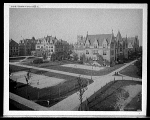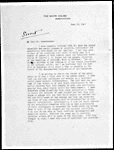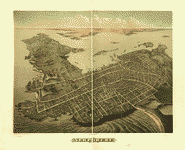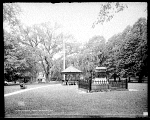Today in History: December 2
"…the Italian Navigator has just landed in the New World…"Coded telephone message confirming first self-sustaining nuclear chain reaction, December 2, 1942.

University of Chicago, Chicago, Illinois, 1907.
Touring Turn-of-the-Century America, 1880-1920
At 3:25 P.M. on December 2, 1942, the Atomic Age began inside an enormous tent on a squash court under the stands of the University of Chicago's Stagg Field. There, scientists headed by Enrico Fermi engineered the first controlled nuclear fission chain reaction. The result, sustainable nuclear energy, led to creation of the atomic bomb and nuclear power plants—two of the twentieth century's most powerful and controversial achievements.
Four years earlier the Italian scientist received the Nobel Prize for Physics. Planning to defect, Fermi attended the award ceremonies in Stockholm with his wife and children. Like so many intellectuals who left fascist Europe, Fermi came to the United States and worked at Columbia University.

S.S. Franconia, 1911.
Touring Turn-of-the-Century America, 1880-1920
Fermi traveled from Europe to New York on the S.S. Franconia.

Declaration of Intention, Number 27081, for Enrico Fermi [Application for U.S. Citizenship]
December 2, 1939.
National Archives and Records Administration
Search the The Archival Research Catalog on Enrico Fermi to find this and other items.
At a physics conference in the U.S., Nobel Prize winning physicist Niels Bohr told Fermi about the findings of Lise Meitner and her nephew Otto Frisch. Meitner worked in Germany with physicists Otto Hahn and Fritz Strassmann until fleeing to Sweden to escape Nazi persecution. From her work in Germany, Meitner knew the nucleus of uranium—235 splits (fission) into two lighter nuclei when bombarded by a neutron. Interestingly, the sum of the particles derived from fission are not equal in mass to the original nucleus. During a visit with her nephew, Meitner speculated that release of energy—energy a hundred million times greater than normally released in the chemical reaction between two atoms—accounted for the difference. Returning to his lab, Frisch explained the theory to Bohr.

Albert Einstein, Doris Ulmann photographer, 1931.
LC-USZ62-72813
Prints and Photographs Division
Within days, Fermi and exiled Hungarian physicist Leo Szilard, realized the first split or fission could cause a second, and so on in a series of chain reactions expanding in geometric progression. They agreed not to publish their findings, lest Germany use them to produce a super weapon. Instead, Szilard and émigré Eugene Wigner persuaded Albert Einstein to write President Franklin D. Roosevelt and request atomic research receive high priority.
Preparing the nation for war, Roosevelt agreed. In December 1941, as the U.S. entered World War II, the project moved to Chicago where Fermi, Walter Zinn, Herbert Anderson, Arthur Compton, and Leo Szilard were the principal team members. Within four years, the Manhattan Project, supervised by J. Robert Oppenheimer, Compton, and Fermi, developed the atomic bomb.

Franklin D. Roosevelt to J. Robert Oppenheimer, June 29, 1943.
Words and Deeds in American History
In this letter, the president thanks Oppenheimer and his colleagues for their ongoing secret atomic research.
Learn more about American scientists:
- Examine the online version of the Alexander Graham Bell Family Papers at the Library of Congress. Use the special presentation Alexander Graham Bell: Inventor and Scientist to access documents, drawings, and images pertinent to Bell's scientific career.
- Read about American scientists from Benjamin Banneker to Willard Libby. Search the Today in History Archive on astronomer, physicist, mathematician, scientist, and science.
- The Nobel Prize is given annually in the areas of Physics, Physiology or Medicine, Chemistry, Economics, Peace and Literature. Search the Today in History Archive on the term Nobel Prize to learn about Americans accorded this honor including Martin Luther King and William Faulkner, winner of the 1949 Nobel Prize for Literature.
- The University of Chicago has played a significant role in the development of both nuclear physics and the study of ecology, fields which are both closely tied to a concern for the future of the American environment. View images from the University's Department of Botany in the collection American Environmental Photographs, 1891-1936. See, for example, A Drain[age] Ditch in Taxodium Swamp in Karnak, Illinois, or the Erosion [of an Environmentally] Devastated [Plain] in Louisiana.
Touro Synagogue

Touro Synagogue, Newport, Rhode Island, Jack Boucher photographer, 1971.
Historic American Buildings Survey,
Considered an architectural masterpiece, Touro Synagogue is the sole surviving synagogue built in colonial America.
On December 2, 1763, members of the Jewish community of Newport, Rhode Island witnessed the dedication of the Touro Synagogue, the first synagogue in what became the United States. Designed in the Georgian style by English architect Peter Harrison, the synagogue was named for Isaac Touro, its first officiating rabbi.
Organized Jewish community life in Newport dates to 1658, when fifteen families emigrated and established a congregation in the growing seaport. Newport was the second oldest Jewish congregation in the future U.S. and the first organized in a British colony. For more than one hundred years the community relied on correspondence with rabbis in Europe to sustain its religious traditions in the New World.

Newport, Rhode Island, 1878.
Cities and Towns,
Map Collections(1500-Present)

Touro Park, Newport, Rhode Island, 1905.
Touring Turn-of-the-Century America, 1880-1920
Newport developed into a thriving commercial center. The Jewish community included a sizeable number of merchants active in the sea trade, and early maps of Newport show Bellevue Avenue lined with shops owned by Jewish merchants of Spanish and Portuguese descent. On August 17, 1790, the Hebrew congregation of Newport welcomed George Washington to their city.
During the second half of the nineteenth century, Newport's temperate climate and scenic location made it a favorite vacation spot for the rich. Newport is filled with "cottages" like Belcourt Castle and The Breakers. Designed by architects like Richard Morris Hunt and landscaped by professionals including Frederick Law Olmsted these mansions provided imposing settings for wealthy Americans like Cornelius Vanderbilt.

The Breakers, Vanderbilt Residence, Newport, Rhode Island, 1904.
Touring Turn-of-the-Century America, 1880-1920
Learn more about the American Jewish experience:
- See the online exhibition Religion and the Founding of the American Republic for information concerning Jewish communities in early America.
- View additional photographs of historic synagogues. Search the American Memory pictorial collections on synagogue.
- Read Louis Leon's Diary of a Tar Heel Confederate Soldier—a Southern Jew's experience of the American Civil War included in First-Person Narratives of the American South, 1860-1920.
- Explore Yiddish theater, a uniquely American dramatic form that developed in urban Eastern European Jewish communities during the early twentieth century. Over seventy-seven Yiddish playscripts are available through the collection American Variety Stage, 1870-1920.
- American Life Histories contains both personal recollections and examples of Yiddish Folklore. Search the collection on jewish to find these and additional materials.